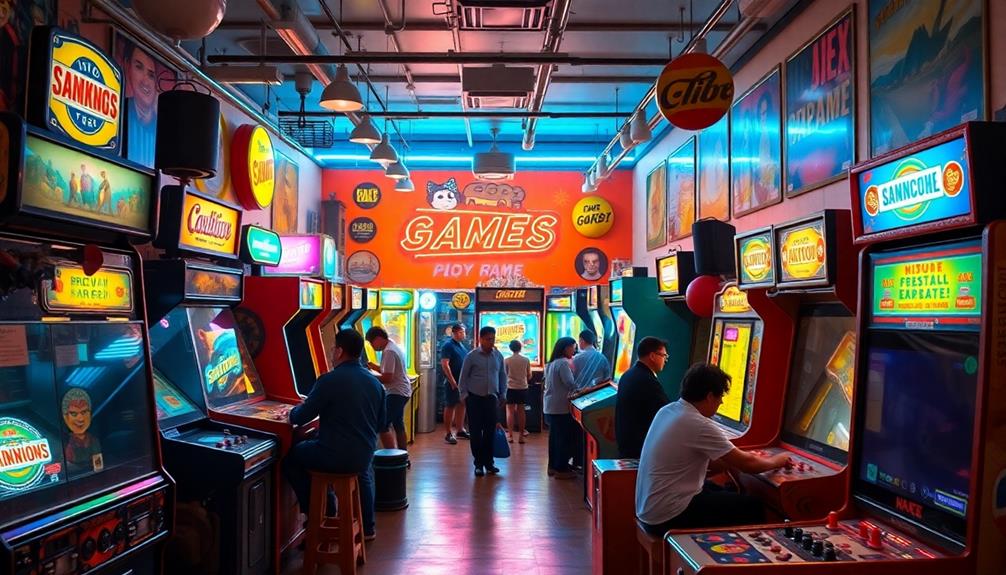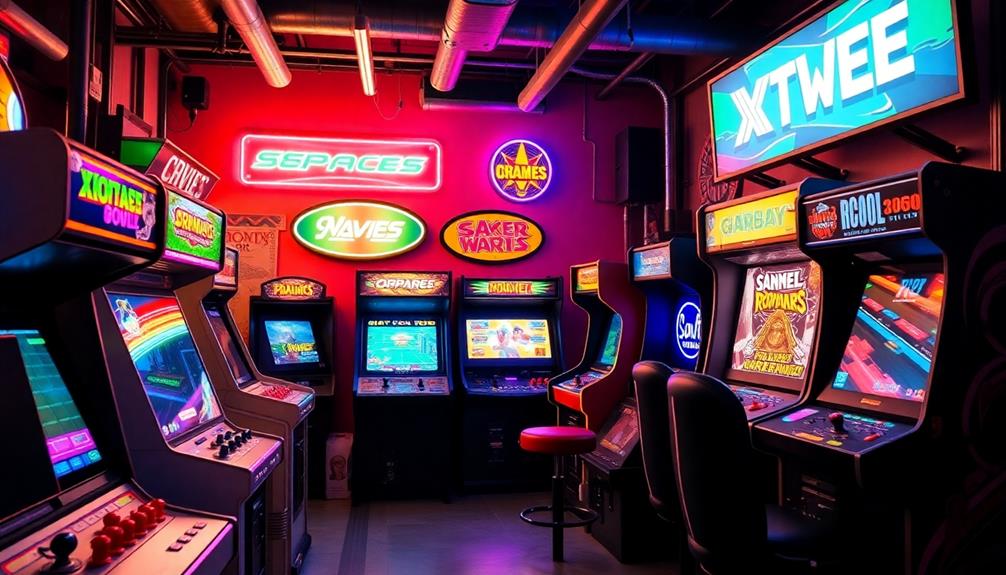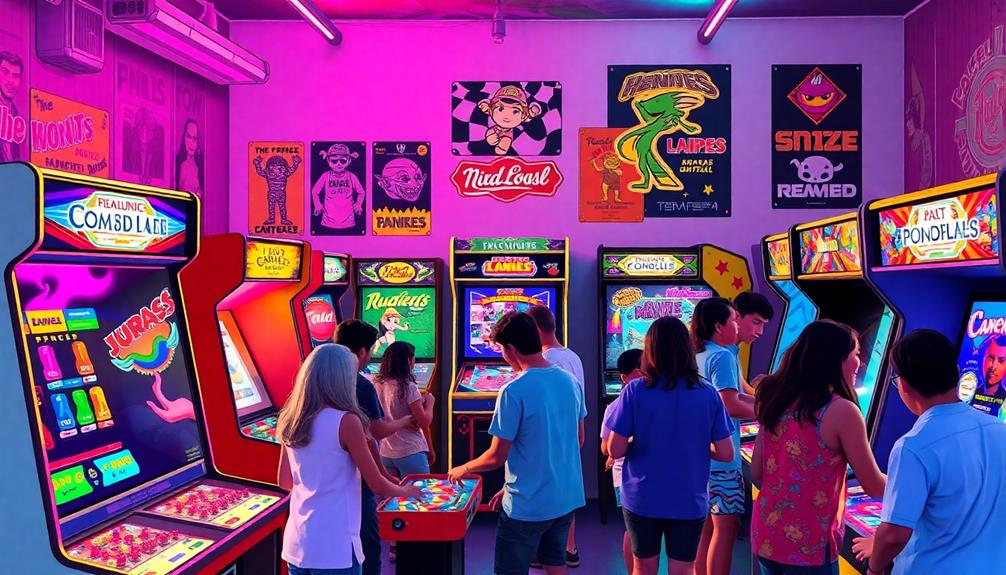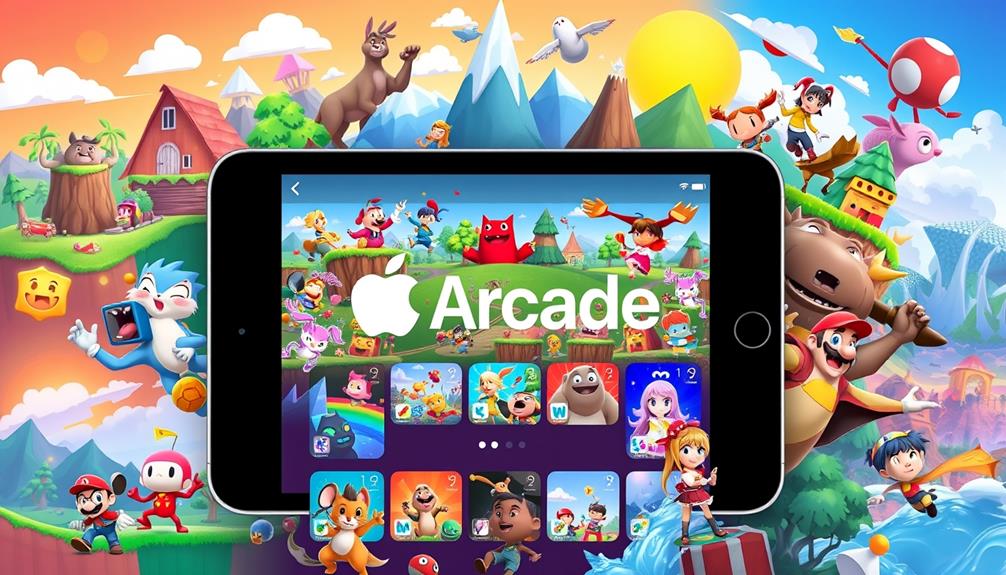Arcade games have been a significant part of entertainment since the early 1970s. It all began in 1971 with “Computer Space,” the first commercially available arcade game. Not long after, “Pong” was introduced in 1972 and quickly became a massive hit, selling over 35,000 units. This paved the way for the Golden Age of Arcades in the late 1970s, which featured legendary games like “Pac-Man” and “Donkey Kong.” Since then, arcades have revolutionized entertainment and created a special community of gamers. The evolution of these gaming spaces has a rich history with fascinating details waiting to be explored.
Key Takeaways
- Arcade games originated in the early 1970s, with "Computer Space" launching in 1971 as the first commercially available arcade video game.
- "Pong," released in 1972, marked the first commercially successful coin-operated arcade game, establishing a booming market.
- The Golden Age of Arcades, spanning from the late 1970s to early 1980s, featured iconic games like "Pac-Man" and "Donkey Kong."
- By January 1982, over 13,000 arcades thrived in the U.S., showcasing the height of arcade popularity.
- Modern arcades face challenges but continue to evolve with innovations like VR and AR for future gaming experiences.
Origins of Arcade Games
The origins of arcade games trace back to the early 1970s, a transformative period that kicked off with the release of "Computer Space" in 1971, the first commercially available arcade video game. This groundbreaking game set the stage for the burgeoning video game industry.
Shortly after, "Galaxy Game" appeared, recognized as the first known coin-operated arcade game, a coin-operated version of the earlier game "Spacewar!" These innovations sparked interest in arcade games, leading to increased investment in the game market.
The rise of arcade games coincided with the growing popularity of pinball machines, which had already captivated audiences for decades, as evidenced by the historical significance of early machines like "Humpty Dumpty" and their impact on gaming culture the history of pinball machines.
In 1972, Atari was founded and soon launched "Pong," the first commercially successful coin-operated arcade game. With over 35,000 units sold by 1973, "Pong" became a cultural phenomenon, catapulting arcade games into mainstream entertainment.
This era laid the groundwork for what would become the Golden Age of Arcade Games, characterized by iconic titles such as "Pac-Man" and "Donkey Kong."
As you explore this fascinating history, you'll see how these early developments not only shaped the arcade landscape but also influenced the future of gaming. The early 1970s truly marked a pivotal moment in the evolution of arcade games.
The Rise of Coin-Operated Games

As arcade games gained traction in the early 1970s, the introduction of coin-operated machines revolutionized the gaming experience, making it accessible to a wider audience.
This era marked the beginning of a new form of entertainment that would lead to the development of various gaming technologies and innovations, including best arcade machines for home game rooms.
The journey began in 1971 with "Computer Space," the first arcade game developed by Nolan Bushnell and Ted Dabney. Shortly after, "Galaxy Game" emerged as the first known coin-operated arcade game, allowing players to enjoy a version of "Spacewar!" with a coin mechanism.
However, it was Atari's "Pong," launched in 1972, that truly changed the game market. This became the first commercially successful coin-operated arcade game, selling over 35,000 units by 1973 and setting a new industry benchmark.
The rapid success of these coin-operated arcade games in the early 1970s laid the foundation for a multi-billion dollar market, greatly influencing entertainment culture.
The Golden Age of Arcades

During the Golden Age of Arcades, you experienced the thrill of iconic game releases like "Space Invaders" and "Pac-Man."
These games didn't just change the landscape of entertainment; they became cultural phenomena that drew people of all ages into arcades.
As gameplay mechanics evolved, you found yourself captivated by the increasing complexity and challenge of these machines.
This period also highlighted the importance of budgeting for entertainment expenses, as players often saved up to enjoy their favorite games.
The excitement in arcades fostered a sense of community among gamers, marking a significant era in video gaming history.
Iconic Game Releases
Arcade games captured the hearts of players in the late 1970s and early 1980s, marking a vibrant period known as the Golden Age of Arcades. During this time, iconic titles emerged, shaping the gaming landscape and drawing in diverse audiences.
Here's a snapshot of some of the standout games:
| Game Title | Release Year | Genre |
|---|---|---|
| Pac-Man | 1980 | Maze Chase Game |
| Donkey Kong | 1981 | Platformer |
| Asteroids | 1979 | Shoot 'em Up |
Pac-Man, created by Toru Iwatani, became a cultural phenomenon, selling over 350,000 cabinets worldwide and appealing to everyone with its non-violent mascot. Donkey Kong, developed by Nintendo, introduced Mario, establishing him as a key character in gaming history and solidifying platformers as a popular genre. Meanwhile, Asteroids proved to be one of the best-selling arcade games of its time, considerably boosting revenue.
The introduction of multiple gameplay genres during this period helped diversify arcade offerings, making the Golden Age of Arcades a truly unforgettable chapter in gaming history.
Cultural Phenomenon Impact
The Golden Age of Arcades transformed gaming into a cultural phenomenon that captivated a generation. Spanning from the late 1970s to the early 1980s, this era saw iconic arcade games like Space Invaders, Pac-Man, and Donkey Kong emerge as powerful forces in the arcade industry.
During this time, the arcade scene became a social hub, similar to how celebrity relationships often shape public perception and culture. Pac-Man, in particular, became a household name, appealing to a diverse audience and greatly increasing female gamers.
By January 1982, over 13,000 arcades thrived in the U.S., with popular machines generating daily profits exceeding $400, showcasing the booming revenues of this entertainment medium.
The success of arcade games during this period laid the groundwork for competitive gaming and gaming tournaments, which would later evolve into today's esports culture.
As arcades flourished, they became embedded in pop culture, influencing merchandise, music, and even fashion. This Golden Age solidified arcade games as more than just pastimes; they became a societal touchstone.
You might find it fascinating how this era not only shaped the gaming landscape but also created a lasting legacy that continues to resonate in modern gaming and entertainment.
Evolution of Gameplay Mechanics
Throughout the Golden Age of Arcades, gameplay mechanics underwent significant evolution, setting the stage for modern gaming. Iconic arcade games like *Space Invaders* and *Pac-Man* transformed player engagement by introducing innovative mechanics. *Pac-Man* pioneered the maze chase genre, focusing on non-violent gameplay that attracted a diverse audience, including many female gamers.
This era also saw the early development of competitive elements, similar to the excitement found in best rated pinball machines of 2024, which further enhanced player interaction.
The arrival of *Donkey Kong* in 1981 diversified gameplay mechanics further by establishing the platformer genre, moving beyond the typical shooting and racing games of the time. With *Asteroids*, players experienced multi-directional controls and strategy, enhancing the complexity of gameplay.
As the Golden Age progressed, competitive gaming began to emerge, culminating in titles like *Street Fighter II*. This game emphasized player skill and strategy in one-on-one combat, refining gameplay mechanics to create a more immersive experience.
The evolution of these arcade games not only captivated players but also laid the groundwork for future gaming innovations. Each title contributed to a shift in how players interacted with games, making them more engaging and challenging. The lasting impact of these mechanics continues to resonate in today's gaming landscape.
Technological Innovations in Arcades

Over the years, technological innovations have transformed the arcade experience, pulling players deeper into immersive gameplay. It all began with Computer Space in 1971, the first mass-produced arcade game that used custom hardware to deliver a unique experience.
You may recall the simplicity of PONG, released by Atari in 1972, showcasing innovative gameplay mechanics that captivated players. The introduction of the Light Gun in 1967 greatly enhanced player interaction, allowing you to aim and shoot at targets on-screen.
In the domain of gaming, understanding how to optimize your setup, such as with essential upgrades and tools, can greatly enhance your experience.
In 1975, the microprocessor made its debut in arcade games with Gun Fight, enabling improved graphics and more complex gameplay. This was a game-changer, as it allowed for richer experiences in video arcade games.
Fast forward to 1983, when Dragons Lair revolutionized the industry by being the first to utilize cel-animated video. This development introduced cinematic storytelling to arcades, setting a new standard for engagement.
These technological advancements not only shaped the arcade landscape but also laid the groundwork for future innovations, ensuring that players like you'd always have something exciting to look forward to in the world of arcade games.
Major Milestones in Arcade History

From the launch of Computer Space in 1971 to the peak of arcade popularity in the early 1990s, several key milestones shaped the arcade gaming landscape. You can see how these events laid the groundwork for the evolution of video games:
| Year | Milestone | Impact |
|---|---|---|
| 1971 | Computer Space | First commercially available arcade game |
| 1972 | Pong | First commercially successful arcade game |
| 1978 | Space Invaders | Introduced shoot 'em up genre |
The release of Pong by Atari in 1972 set a benchmark, selling over 35,000 units. Then, Space Invaders hit the scene in 1978, boosting arcade revenues with over 100,000 machines sold in Japan. This period, known as the Golden Age of arcade games, featured iconic titles like Pac-Man and Donkey Kong, transforming arcade gaming into a cultural phenomenon. By 1990, the arcade landscape peaked, with over 25,000 arcade locations across the United States, showcasing the immense popularity and commercial success of arcade games during that time.
Cultural Impact of Arcades

Arcades have shaped pop culture in ways you mightn't even realize, from iconic games like "Pac-Man" to their influence on movies and merchandise.
These gaming hubs also fostered social interactions, creating vibrant communities where friendships formed over high scores and competitions.
The rise of arcade games coincided with a significant cultural shift, as they became a form of entertainment that blended technology with social engagement, reflecting the era's evolving dynamics.
As you explore their cultural impact, you'll see how arcades became an essential part of the entertainment landscape, often paralleling trends in astrology and attractiveness that influence how communities connect and engage.
Arcade Games in Pop Culture
When you think about the evolution of entertainment, arcade games stand out as a cultural phenomenon that shaped the landscape of gaming. It all kicked off with PONG in 1972, marking the beginning of a multi-billion dollar industry that made arcade gaming mainstream.
The introduction of Pac-Man in 1980 diversified the gaming audience, appealing to women and younger players while becoming an iconic character in pop culture. This led to a surge in merchandise sales and a lasting impact on cultural identity, much like the celebrity weddings that resonate with fans and attendees alike.
During the Golden Age of Arcade Games in the late 1970s and early 1980s, titles like Space Invaders and Donkey Kong not only generated substantial revenue but also influenced future game development.
The rise of video game tournaments in the 1980s, especially with Street Fighter II, established competitive gaming as a cultural fixture, laying the groundwork for modern esports.
Today, classic arcade games enjoy a resurgence in popularity, with nostalgia-driven venues like barcades attracting adult audiences.
This revival emphasizes the lasting significance of arcade gaming experiences, proving that their cultural impact continues to resonate across generations.
Social Interaction and Community
The vibrant atmosphere of arcade gaming has always fostered a strong sense of community among players. From the early 1970s, over 13,000 arcades emerged in the U.S., creating social hubs where gamers could connect. Iconic titles like Pac-Man and Donkey Kong weren't just games; they encouraged group play and competitive spirit, making every visit an engaging experience.
Additionally, much like how certain foods can promote healthier lifestyles, arcade games have been linked to fostering social connections and enhancing mental well-being through interactive play beneficial for overall health.
Here are three key aspects of this social interaction:
- Tournaments: The 1980s introduced competitive tournaments, like those organized by Twin Galaxies, encouraging players to showcase their skills and build camaraderie.
- Barcades: Recently, barcades have become popular, blending gaming and nightlife, allowing former arcade-goers to relive their youth in a fun environment.
- Nostalgic Revival: Mobile platforms and retro-themed events have sparked a nostalgic revival, reinforcing community ties and collective memories among gamers.
In this way, arcade games have consistently served as a catalyst for social interaction, creating lasting connections and a vibrant community that thrives on friendly competition and shared experiences.
Challenges Facing Modern Arcades

Modern arcades face a myriad of challenges that threaten their survival and growth. The COVID-19 pandemic has led to over 8,000 closures and a significant decline in foot traffic. Large game companies now see remaining arcades as declining investments, with many reporting financial struggles. As nostalgia for classic arcade experiences resurges, mobile platforms have capitalized on this trend, but it poses a threat to traditional arcades.
| Challenge | Impact on Arcades |
|---|---|
| Financial Struggles | Limited resources for new games |
| Declining Investments | Less support from large companies |
| Shift to Redemption Games | Traditional arcade games are losing popularity |
| Nostalgia for Classics | Players may prefer mobile gaming |
| VR and AR Technologies | High costs to implement innovations |
While redemption games like claw machines gain popularity, they often lack the player engagement found in classic arcade games. Innovations in VR and AR technologies could rejuvenate the arcade experience, but high costs and uncertain returns make them risky ventures. Without adapting to these challenges, modern arcades risk becoming relics of the past.
The Future of Arcade Gaming

As technology evolves, arcade gaming is poised for an exciting transformation. The future promises to blend the nostalgia of classic arcade gameplay with cutting-edge innovation. With the rise of games that evoke feelings of joy and nostalgia, like Blue Skies and Lemonade by Rhythm Failure, you can expect a resurgence of uplifting themes in arcade experiences.
Here's what you can expect:
- Integration of VR and AR: These technologies will create immersive experiences, allowing you to step into the game like never before. Imagine battling in a virtual arena or solving puzzles in an augmented space.
- Revival of Competitive Gaming: Tournaments and competitions are gaining traction, fostering community engagement and excitement around arcade games. You'll find yourself in a vibrant atmosphere where you can connect with other gamers.
- Evolving Redemption Games: With a shift towards redemption games, arcades are diversifying their offerings. You'll see new games that reward skill and luck, making your visits even more rewarding.
Despite challenges, the arcade industry is adapting. Manufacturers like Raw Thrills and LAI Games are innovating while preserving the essence of traditional video arcade games.
As you step into the arcade of the future, you'll witness a blend of nostalgia and modern experiences, ensuring that this beloved pastime continues to thrive.
Frequently Asked Questions
When Did Arcade Games Start?
Arcade games started in 1971 with "Computer Space," the first commercially available title. Shortly after, "Pong" launched in 1972, marking the rise of arcade gaming and paving the way for many iconic games to follow.
Were Arcades Around in the 70S?
Yes, arcades were definitely around in the 70s. You'd find them bustling with players enjoying classics like "Pong" and "Space Invaders," which fueled a massive growth in the arcade gaming industry during that decade.
Did People Go to Arcades in the 80S?
Visiting arcades in the 80s was like stepping into a vibrant carnival. You'd find crowds gathered around popular games, enthusiastically competing and bonding over high scores, making it a thrilling social hub for everyone involved.
What Era Were Arcade Video Games?
Arcade video games flourished during the late 1970s and 1980s, peaking in popularity. You'd find iconic titles like Pong and Space Invaders enthralling players, making arcades a vibrant hub for entertainment and social interaction.
Conclusion
Arcade games have been a beloved part of entertainment for decades, and their legacy is undeniable. As you reminisce about those vibrant, buzzing arcades, remember that they shaped not just gaming, but also friendships and memories. Despite facing challenges today, the spirit of arcades lives on. Whether you're revisiting an old favorite or discovering a new game, you're contributing to a rich history that's about connection and joy—something that never truly fades away. As technology continues to advance, the future of arcade gaming holds endless possibilities. With virtual reality, augmented reality, and other innovations, arcades are evolving to offer even more immersive and exciting experiences. The future of arcade gaming is bright, and it’s exciting to think about the new memories and friendships that will be made in the years to come.









